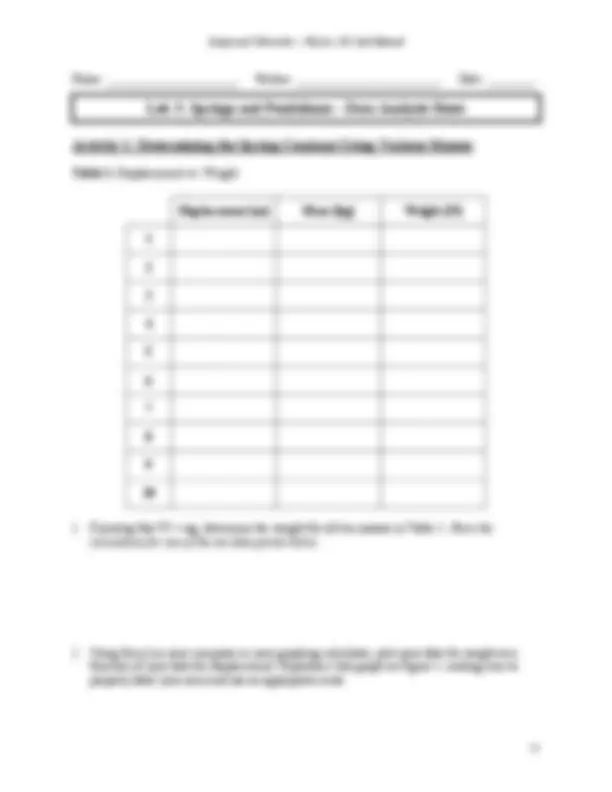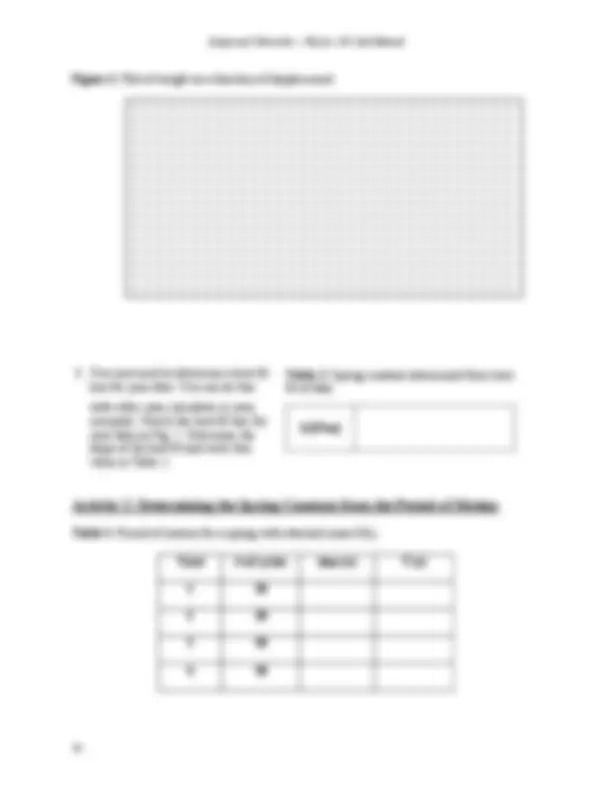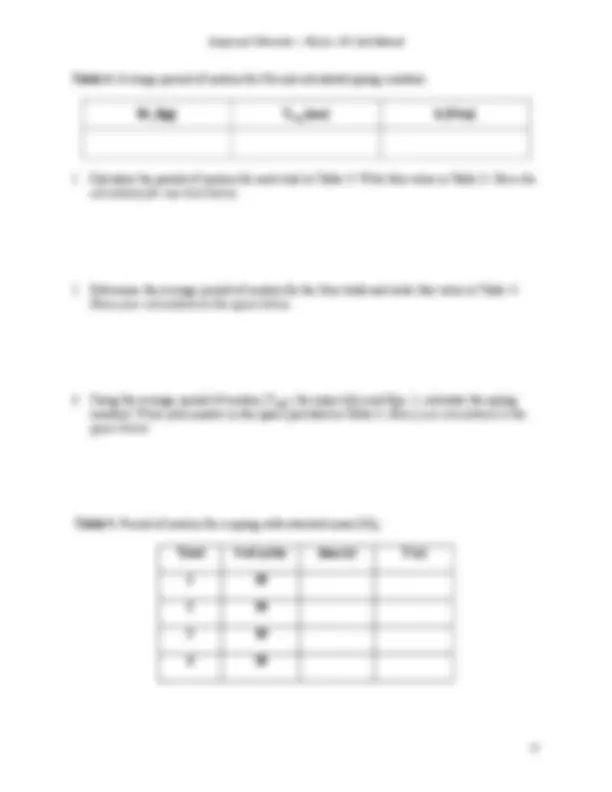





Study with the several resources on Docsity

Earn points by helping other students or get them with a premium plan


Prepare for your exams
Study with the several resources on Docsity

Earn points to download
Earn points by helping other students or get them with a premium plan
Community
Ask the community for help and clear up your study doubts
Discover the best universities in your country according to Docsity users
Free resources
Download our free guides on studying techniques, anxiety management strategies, and thesis advice from Docsity tutors
Material Type: Lab; Class: General Physics II; Subject: Physics; University: Longwood University; Term: Unknown 1989;
Typology: Lab Reports
1 / 7

This page cannot be seen from the preview
Don't miss anything!




For springs, Hooke’s Law tells us that the displacement (x) of the spring from equilibrium is proportional to the force (F) applied to the spring:
F = − kx (1),
where k is the spring constant. Equation 1 is a linear equation with a slope of k. This mean if you plot the weight hanging from a spring (F) as a function of the displacement from equilibrium (x), then the plot should be linear with the slope of the line being equal to the spring constant (k).
If the spring with hanging mass is set in motion, then its motions will be simple harmonic, meaning that the mass will oscillate around its equilibrium point. The period of motion (T) is the time it will take to make one complete oscillation and is dependent on the mass of the spring (m) and the spring constant (k), as follows:
k
m
Using Equ. 2 we can also determine the spring constant from the period of motion.
Another type of system that exhibits simple harmonic motion is the oscillation of a pendulum (for small angles). The period of motion for a pendulum (T) depends on the length of the pendulum (L) and the acceleration due to gravity (g) according to the following:
g
Using Equ. 3 we can determine the acceleration due to gravity by measuring the period of an oscillating pendulum.
In this lab, you will complete three activities using these concepts concerning springs, pendulums and simple harmonic motion. Specifically, you will measure the spring constant of a given spring two ways: (1) by observing its displacement and (2) by measuring its period of motion. In the final activity, you will determine the acceleration due to gravity by measuring the period of a pendulum.
The principles in this lab should reinforce the following concepts:
Activity 1: Determining the Spring Constant Using Various Masses
Equipment: spring, spring holder, mass holder, 10 masses, computer or graphing calculator.
(1) Place a small amount of mass on the mass holder that is attached to the spring so that the spring displaces slightly. Move the scale so that it is zeroed at the location of the pointer on the mass holder. This is now your equilibrium position. (2) Add a small amount of mass to the mass holder and record the new total mass and displacement for this mass in Table 1 of the Data Analysis sheet. [IMPORTANT: Do not include the original mass from step 1.] (3) Repeat step 2 until you have 10 data points. (4) Complete the Data Analysis sheet for Activity 1 before moving on to Activity 2
Activity 2: Determining the Spring Constant from the Period of Motion
Equipment: spring, spring holder, two 20 gram masses, stopwatch.
(1) Place 20 grams on the mass holder. This will cause the spring to displace. (2) Gently pull the mass down and let go. Pay particular attention to the word “gently”. DO NOT over-stretch the spring. (3) Using the stopwatch determine how long it takes for the mass to go through 10 cycles of motion. Write this value down in Table 3 of the Data Analysis sheet. (4) Repeat steps 2 and 3 until you have 4 different trials. (5) Repeat steps 2 through 4 using 40 grams of mass on the holder. Record all values in Data Table 5 of the Data Analysis sheet. (6) Complete the Data Analysis sheet for Activity 2 before moving on to Activity 3.
Activity 3: Determining the Acceleration due to Gravity from Period of Motion
Equipment: 1 meter length of string, pendulum holder, small mass, stopwatch.
(1) Measure the length of the string for your pendulum and record the value in Data Table 7 of the Data Analysis sheet. Be sure to measure from the pivot point to the center of mass of the hanging weight. (2) Displace the pendulum no more than 15 ° from its equilibrium position. Release the pendulum and allow it to swing freely. (3) Using a stopwatch determine how long it takes for the pendulum to go through 10 cycles of motion. Write this value down in Table 7 of the Data Analysis sheet. (4) Repeat steps 2 and 3 until you have 3 different trials. Record all values in Data Table 7 of the Data Analysis sheet. (5) Complete the Data Analysis sheet for Activity 3.
Figure 1: Plot of weight as a function of displacement.
Table 3: Period of motion for a spring with attached mass (M 1 ).
Trial # of cycles time (s) T (s)
1 10
2 10
3 10
4 10
k [N/m]
Table 2: Spring constant determined from best- fit of data.
Table 4: Average period of motion for M 1 and calculated spring constant.
M 1 [kg] Tavg [sec] k [N/m]
Table 5: Period of motion for a spring with attached mass (M 2 ).
Trial # of cycles time (s) T (s)
1 10
2 10
3 10
4 10
Table 8: Acceleration due to gravity and percent error from known value.
g [m/s^2 ]
Percent Error [%]
100 %
exp ×
K
K g
g g Error
where gK is the known value for the acceleration due to gravity [9.8 m/s^2 ]. Record this value in Table 8. Show your calculation in the space below.